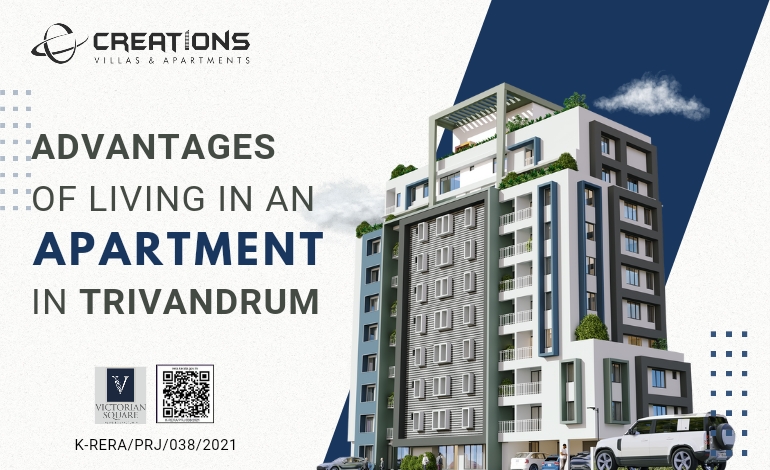
Why Investing in a Creations Apartment Project is a Smart Move for Homebuyers
Home is where the heart is. And trust us when we say this, Creations Villas & Apartments are homes built with their hearts in the

Discover Modern Fresh Living Apartments in Trivandrum – Creations Villas & Apartments
Trivandrum, the vibrant capital of Kerala, is witnessing a surge in demand for modern living spaces that seamlessly blend contemporary design with comfort. Among the

Creations Villas & Apartments – The Pioneers Among Top Builders in Trivandrum
Homes are forever. So, when your journey to find the perfect one begins, we understand you’ll look at all the fine details—from the quality of

Comfort and Space Redefined: Finding the Ideal 3 BHK Apartments in Trivandrum for Your Family
Your family is your priority. You want to give your loved ones the most comfortable and spacious living experience in a clean, safe, and well-equipped

Family Living: Why a 3 BHK Apartment in Trivandrum is Ideal?
Trivandrum—a city of culture, modern developments, quality education and healthcare, and growing opportunities. Add to this the serene and natural beauty of the city situated

Top 2 BHK Apartments in Trivandrum for First-Time Homebuyers
If you’re a first-time homebuyer, we, at Creations Villas & Apartments, the best builders in Trivandrum, are as excited as you are! Buying a home

Budget-Friendly 1 BHK Apartments Near Lulu Mall by Creations Villas & Apartments
Dreaming of a cozy, budget-friendly 1 BHK apartment in Trivandrum? You’ve headed in the right direction with Creations Villas & Apartments! You’ll find the best

How to Choose the Perfect Apartment in Trivandrum for Your Family?
Apartments in Trivandrum – have you been thinking about them? If yes, then congratulations – you’ve been thinking right! Because finding the perfect apartments in

The Ultimate Guide to Finding the Best Flats and Apartments for Sale in Trivandrum
If you’re looking for apartments in Trivandrum, allow us first to congratulate you on your choice of city! Trivandrum also known as Thiruvananthapuram, beautifully blends

Investing in Trivandrum Real Estate: Flats and Apartments for Sale in Trivandrum
If you’ve answered ‘yes’ to these questions, allow us to help you! We are Creations Villas & Apartments, the best builders in Trivandrum, with nearly

Affordable Luxury: 3 BHK Apartments in Trivandrum
A warm welcome to Trivandrum City, a gentle fusion of traditional and modern worlds, none overpowering the other, but co-existing in a beautiful tandem. Whether

Why 1 BHK Apartments in Trivandrum are a Wise Choice?
A cozy home is a place of rest, not of obligation. And yet, homes are getting unwieldily larger and stuffed with a million things people

Finding Your Dream Home: Brand New 2 BHK Apartments in Trivandrum
Are brand new 2 BHK apartments in Trivandrum on your mind? We’re so excited to introduce two fabulous and soon-to-be-launched 2 BHK flats in Trivandrum

Neil Castle – 2 BHK Apartments Near Lulu Mall Trivandrum
Trivandrum – it’s a city where culture, character, and cosmopolitan lifestyle come together delightfully. If you have 2 BHK apartments in Trivandrum on your mind,

Discover a Luxurious Life at Victorian Square – 2 BHK Apartments in PMG, Trivandrum
A modern apartment project in a beautiful city at a convenient location – how easy is it to find such a perfect combination of good

Flats and Apartments for Sale in Trivandrum
The beautiful city of Trivandrum stands as a testament to its glorious history, embracing modern sensibilities and urban lifestyle. The capital city of Kerala is

Neil Castle – 1 BHK Apartments Near Lulu Mall Trivandrum
There’s a special charm to a compact apartment in a tranquil city. So, if you’ve been looking for 1 BHK apartments in Trivandrum, Creations, the

Victorian Square – 3 BHK Apartment in PMG, Trivandrum
A 3 BHK apartment in Trivandrum is a dream come true for anyone looking for a fair investment for their family. But a 3 BHK

Advantages of Living in an Apartment in Trivandrum
Trivandrum. A city of culture, traditions, arts, education, healthcare, business, and tourism. A city that spells tranquility and safety, as much as it stands for

Luxury Apartments in Trivandrum by Creations Villas & Apartments
Get set to experience luxury and comfort with Creations Villas & Apartments, the best builders in Trivandrum. Our apartments in Trivandrum redefine opulent living without

Vivian Suites – The Best 2 & 3 BHK Apartments in Mannanthala, Trivandrum
Are you ready to experience the luxurious charm of Creations Vivian Suites’ 2 BHK and 3 BHK apartments in Trivandrum? Then get ready for the

Neil Castle: 1, 2 & 3 BHK Apartment Near Lulu Mall, Trivandrum’s Prime Location
Neil Castle: A Jewel Near Lulu Mall, Trivandrum’s Prime Location Is a luxurious and comfortable living space in Trivandrum’s prime location your dream? Are you

Victorian Square – The Best 2 & 3 BHK Apartment in PMG Jn. Trivandrum
Welcome to the pinnacle of modern living at PMG junction, Trivandrum, where Creations Kerala brings to you Victorian Square, our luxury apartment project. Indulge in

The Most Trusted Builders In Trivandrum – Creations Villas & Apartments
Trivandrum, the bustling capital city of Kerala is a confluence of tradition and modernity. If you are looking for a dream home here, remember that

